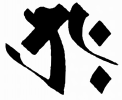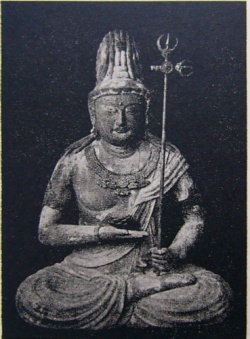Difference between revisions of "Ākāśagarbha Mantra"
(Created page with "thumb|250px| thumb|250px|ā kā śa ga rbha Ākāśagarbha (Japanese: 虚 空 蔵 = kokūzō) is an import...") |
|||
| Line 1: | Line 1: | ||
[[File:KOKYUZO Akasagarbha Shingoji.JPG|thumb|250px|]] | [[File:KOKYUZO Akasagarbha Shingoji.JPG|thumb|250px|]] | ||
[[File:Akasagarbhama.png|thumb|250px|ā kā śa ga rbha]] | [[File:Akasagarbhama.png|thumb|250px|ā kā śa ga rbha]] | ||
| − | Ākāśagarbha (Japanese: 虚 空 蔵 = kokūzō) is an important figure in far eastern Buddhism. His emblems are the sword and cintamani (or wish fulling jewel). He is sometimes shown as here, and sometimes with his right hand in the varada, or giving, mudra. He is one of the eight Great Bodhisattvas. | + | [[Ākāśagarbha]] ({{Wiki|Japanese}}: 虚 空 蔵 = kokūzō) is an important figure in far eastern [[Buddhism]]. His emblems are the sword and [[cintamani]] (or wish fulling [[jewel]]). He is sometimes shown as here, and sometimes with his right hand in the varada, or giving, [[mudra]]. He is one of the eight Great [[Bodhisattvas]]. |
| − | Ākāśagarbha is very important in the life story of Kūkai. As a teenager he met a Buddhist priest who taught him a mantra of Ākāśagarbha known in Japanese as Gumonji-hō, also known as the Morning Star Mantra (see below). It was in repeating this mantra millions of times that he had some decisive spiritual experiences, including many powerful visions of Ākāśagarbha. | + | [[Ākāśagarbha]] is very important in the [[life]] story of [[Kūkai]]. As a teenager he met a [[Buddhist]] priest who taught him a [[mantra]] of [[Ākāśagarbha]] known in {{Wiki|Japanese}} as Gumonji-hō, also known as the Morning Star [[Mantra]] (see below). It was in repeating this [[mantra]] millions of times that he had some decisive [[spiritual]] [[experiences]], including many powerful visions of [[Ākāśagarbha]]. |
==Seed Syllable== | ==Seed Syllable== | ||
| − | The seed syllable of Ākāśagarbha is trāḥ, which is also associated with Ratnasambhava in some mandalas. <br/> | + | The seed syllable of [[Ākāśagarbha]] is trāḥ, which is also associated with [[Ratnasambhava]] in some [[mandalas]]. <br/> |
[[File:Traah.png|frameless|250px|]] | [[File:Traah.png|frameless|250px|]] | ||
| Line 16: | Line 16: | ||
'''oṃ va jra ra tna oṃ trāḥ svā hā | '''oṃ va jra ra tna oṃ trāḥ svā hā | ||
| − | '''oṃ vajra ratna oṃ trāḥ svāhā | + | '''oṃ [[vajra]] [[ratna]] oṃ trāḥ [[svāhā]] |
| − | The Japanese pronunciation of this mantra is: | + | The {{Wiki|Japanese}} pronunciation of this [[mantra]] is: |
'''om bazara aratanno om taraku sowaka | '''om bazara aratanno om taraku sowaka | ||
| Line 24: | Line 24: | ||
==Morning Star Mantra== | ==Morning Star Mantra== | ||
| − | This mantra is very important in Shingon Buddhism and comes from a text known in Japanese as Kokūzō bosatsu nō man shogan saishō shin darani gumonji hō (虛空藏菩薩能滿諸願最勝心陀羅尼求聞持法 : T 20 #1145). Repeated one million times according to the requisite rituals, in a certain time period, one gains the ability to remember and understand any text. | + | This [[mantra]] is very important in [[Shingon]] [[Buddhism]] and comes from a text known in {{Wiki|Japanese}} as [[Kokūzō bosatsu]] nō man shogan saishō shin darani gumonji hō (虛空藏菩薩能滿諸願最勝心陀羅尼求聞持法 : T 20 #1145). Repeated one million times according to the requisite [[rituals]], in a certain [[time]] period, one gains the ability to remember and [[understand]] any text. |
[[File:Akasagarbha-morningstar.png|frameless|450px|]] | [[File:Akasagarbha-morningstar.png|frameless|450px|]] | ||
| Line 33: | Line 33: | ||
'''na mo ā kā śa ga rbha ya oṃ ā rya ka ma ri mau li svā hā | '''na mo ā kā śa ga rbha ya oṃ ā rya ka ma ri mau li svā hā | ||
| − | '''namo ākāśagarbhaya oṃ ārya kamari mauli svāhā | + | '''[[namo]] ākāśagarbhaya oṃ [[ārya]] kamari mauli [[svāhā]] |
| − | The Japanese pronunciation of this mantra is: | + | The {{Wiki|Japanese}} pronunciation of this [[mantra]] is: |
| − | '''nōbō akyasha kyarabaya on ari kyamari bori sowaka | + | '''nōbō akyasha kyarabaya on [[ari]] kyamari bori sowaka |
{{R}} | {{R}} | ||
Revision as of 08:22, 4 September 2013
Ākāśagarbha (Japanese: 虚 空 蔵 = kokūzō) is an important figure in far eastern Buddhism. His emblems are the sword and cintamani (or wish fulling jewel). He is sometimes shown as here, and sometimes with his right hand in the varada, or giving, mudra. He is one of the eight Great Bodhisattvas.
Ākāśagarbha is very important in the life story of Kūkai. As a teenager he met a Buddhist priest who taught him a mantra of Ākāśagarbha known in Japanese as Gumonji-hō, also known as the Morning Star Mantra (see below). It was in repeating this mantra millions of times that he had some decisive spiritual experiences, including many powerful visions of Ākāśagarbha.
Seed Syllable
The seed syllable of Ākāśagarbha is trāḥ, which is also associated with Ratnasambhava in some mandalas.

Mantra
Transliteration
oṃ va jra ra tna oṃ trāḥ svā hā
The Japanese pronunciation of this mantra is:
om bazara aratanno om taraku sowaka
Morning Star Mantra
This mantra is very important in Shingon Buddhism and comes from a text known in Japanese as Kokūzō bosatsu nō man shogan saishō shin darani gumonji hō (虛空藏菩薩能滿諸願最勝心陀羅尼求聞持法 : T 20 #1145). Repeated one million times according to the requisite rituals, in a certain time period, one gains the ability to remember and understand any text.
Transliteration
na mo ā kā śa ga rbha ya oṃ ā rya ka ma ri mau li svā hā
namo ākāśagarbhaya oṃ ārya kamari mauli svāhā
The Japanese pronunciation of this mantra is:
nōbō akyasha kyarabaya on ari kyamari bori sowaka


